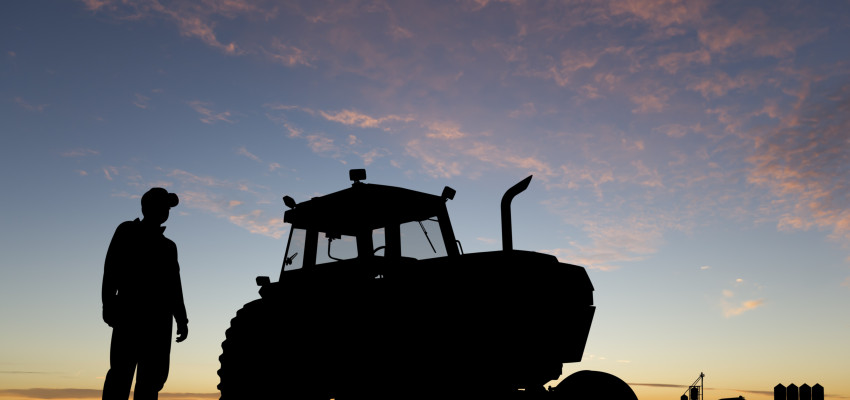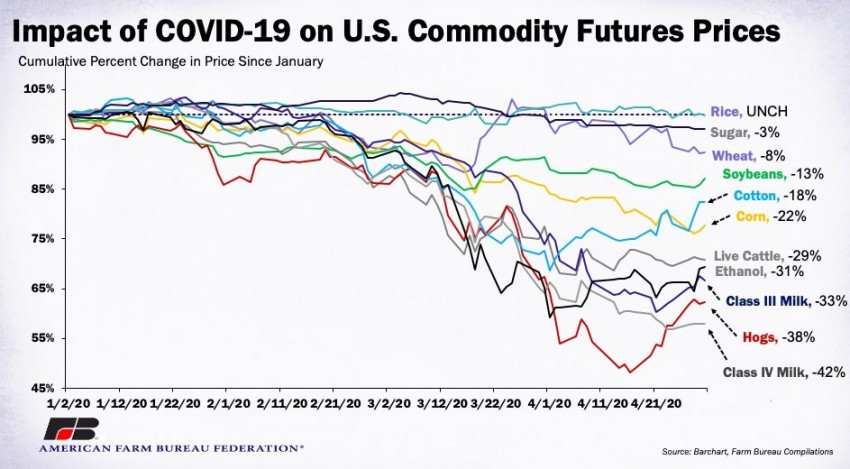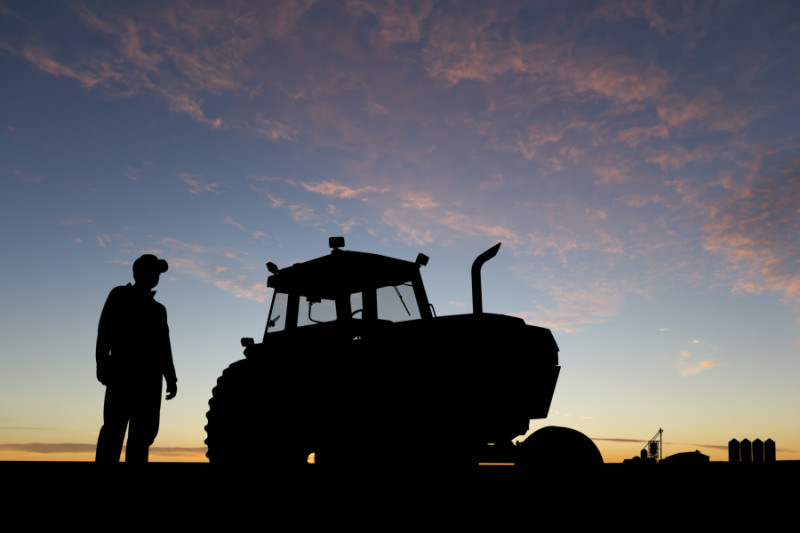By Kansas Living on April 28, 2020
The Farm Economy and COVID-19

The coronavirus has caused major disruptions in almost every sector of agriculture. A host of issues mean we see shortages at the grocery stores. None of these issues are simple, and if you're like us, sorting through all of it can be overwhelming. We gathered a few common questions from consumers and asked Kansas farmers to share their perspectives. Have questions yourself? Send us a message.
How was the farming economy before COVID-19?
LaVell Winsor:
 We raise corn, soybeans and cattle near Topeka. I also help farmers with their finances through my work. Honestly, there were a lot of farms that were struggling with barely breaking even prior to the current situation. Crop prices have mostly fallen below break even. Meaning right now, without improvement, many will lose money on what they are planting this spring. It's very difficult because so many purchases were already made (seed and fertilizer) so you about have to go ahead and plant. It's a grim choice...
We raise corn, soybeans and cattle near Topeka. I also help farmers with their finances through my work. Honestly, there were a lot of farms that were struggling with barely breaking even prior to the current situation. Crop prices have mostly fallen below break even. Meaning right now, without improvement, many will lose money on what they are planting this spring. It's very difficult because so many purchases were already made (seed and fertilizer) so you about have to go ahead and plant. It's a grim choice...
This year is a point where modern crop insurance shows its importance (crop insurance is a little like insurance on your car or house, it may not make you whole, but it helps when something bad happens). Basically a revenue guarantee was put into place before prices fell. For our farm, this hopefully will let us squeak by to minimize loss. Many farmers say crop insurance is the most highly important item to them in the farm bill.
Debbie Lyons-Blythe:
 We raise cattle, corn, soybeans and some wheat. To be honest, prices before COVID-19 were pretty mediocre. Corn was low because the price of gas is so low. Ethanol from corn is profitable when gas is high, so the demand for corn is high then too. But with low gas prices, corn demand is relatively low and therefore price is low.
We raise cattle, corn, soybeans and some wheat. To be honest, prices before COVID-19 were pretty mediocre. Corn was low because the price of gas is so low. Ethanol from corn is profitable when gas is high, so the demand for corn is high then too. But with low gas prices, corn demand is relatively low and therefore price is low.
When quarantine hit, prices all dropped like a rock! We need people at every stage along the production line to be healthy and at work. If any sector has to shut down, it backs up product. For example, as packing plants shut down because of COVID-19 cases in the worker population are not slaughtering cattle and my pen of cattle that are ready to be slaughtered will stay at the feedyard still eating and taking up space. I will still have to pay for their feed and care and "yardage," which means pen space, until the packer can get back to work and catch up on the cattle that have been in line.
It is the law of supply and demand at that point--I am still producing supply--cattle are being fed and readied for harvest, but with a packing plant closed, there is less demand for them at that point in the food production chain.
Katie Sawyer:
My husband and I raise crops and cattle in Central Kansas and, in all honestly, COVID-19 has only made a tough situation even worse. There is in no way a shortage of food - quite the opposite in fact - but the way people consume food - at home versus at school, in restaurants and at events and venues - has forced our food manufacturers, supply chains and vendors to undergo some massive changes in a matter of days and weeks.
Additionally, sickness is hitting food manufacturing workers and slowing their production rates - which all means a few less items on the shelves at the grocery store. But don’t worry - they are coming - because farmers are still growing crops, raising animals and producing milk.
Marieta Hauser:
 We farm in Southwest Kansas on non-irrigated farm ground. We grow wheat, milo or grain sorghum as it is also known and a little bit of corn. I work off the farm as Director of our Chamber of Commerce in a community that relies heavily on agriculture and agribusiness to make our economy work. The farm economy before COVID-19 wasn’t great, we held on to some of last year’s fall crops hoping that we could catch the market on a high note. Finally, with bills that needed to be paid and storage costs for the grain, we made the decision to sell. I’m glad now that we did, the prices have not been very good and holding on to it would have incurred more cost.
We farm in Southwest Kansas on non-irrigated farm ground. We grow wheat, milo or grain sorghum as it is also known and a little bit of corn. I work off the farm as Director of our Chamber of Commerce in a community that relies heavily on agriculture and agribusiness to make our economy work. The farm economy before COVID-19 wasn’t great, we held on to some of last year’s fall crops hoping that we could catch the market on a high note. Finally, with bills that needed to be paid and storage costs for the grain, we made the decision to sell. I’m glad now that we did, the prices have not been very good and holding on to it would have incurred more cost.
We have seen the grain markets fall during the COVID-19 outbreak to a level that we will struggle to make a profit from the farm this year. An even larger issue for our farm is the lack of moisture. Our wheat is way behind where it should be because it didn’t get any rain to sprout it until after winter. It is very thin and in most fields, it would cost us more to take the combines in and cut it than we would receive for the meager amount of grain that will be there. We may destroy some of it(we hate to do that because of the cost of planting that crop) and put in milo or corn. That is a hard decision for us to make because we will have the expense of putting in a second crop and we still have had no moisture and there is none forecast in the foreseeable future. While COVID-19 has sent the markets on a downward trend, for our farm, Mother Nature has been the bigger challenge.
Which farmers have been hit the hardest since COVID-19?
All farmers and ranchers are affected by COVID-19. This graph shows the major impact on commodities.
Marieta Hauser:
 This is a tough one. I know dairy and hog farmers have really taken a hit because their commodities don’t “hold” well. When the packing plants shut down, the hogs that are ready to be harvested have nowhere to go with them. When the schools and restaurants shut down, the dairy processing plants that supplied their needs in packaging that is different than what you and I buy in the store, didn’t need the milk that was produced from the dairies that were supplying them because they had no demand for that specific packaged product. The processing plants can’t just convert to gallon and half gallon bottling so much of the milk destined to end up at schools and restaurants had to be dumped because it couldn’t be processed and packaged for the current demand of the consumers. The demand for the current consumers home needs, gallon and half gallons, were still being produced at the normal level but the demand is much greater because more people are staying at home to eat and drink their meals.
This is a tough one. I know dairy and hog farmers have really taken a hit because their commodities don’t “hold” well. When the packing plants shut down, the hogs that are ready to be harvested have nowhere to go with them. When the schools and restaurants shut down, the dairy processing plants that supplied their needs in packaging that is different than what you and I buy in the store, didn’t need the milk that was produced from the dairies that were supplying them because they had no demand for that specific packaged product. The processing plants can’t just convert to gallon and half gallon bottling so much of the milk destined to end up at schools and restaurants had to be dumped because it couldn’t be processed and packaged for the current demand of the consumers. The demand for the current consumers home needs, gallon and half gallons, were still being produced at the normal level but the demand is much greater because more people are staying at home to eat and drink their meals.
Do commodity prices directly correlate to how profitable a farm is?
Debbie Lyons-Blythe:
 Yes commodity prices do DIRECTLY impact my ranch's ability to make money. That is our paycheck. And commodity prices fluctuate for many reasons--global reasons. We have ups and downs. This is a pretty major down. But we keep planting seed. Keep breeding cows. Keep taking care of the land. Farmers and ranchers have to be optimists! It will get better. It may get worse. But we keep doing what we do and we will get through it.
Yes commodity prices do DIRECTLY impact my ranch's ability to make money. That is our paycheck. And commodity prices fluctuate for many reasons--global reasons. We have ups and downs. This is a pretty major down. But we keep planting seed. Keep breeding cows. Keep taking care of the land. Farmers and ranchers have to be optimists! It will get better. It may get worse. But we keep doing what we do and we will get through it.
Katie Sawyer:
Yes, there is a correlation between commodity prices and a farmer’s income. There are other variables involved but when commodity prices are down, farm income is down and, unfortunately, it has been that way for several years now.
But ask any farmer and they will tell you they don’t do it to get rich, they do it because they love making a living in a tractor, raising animals and taking care of the land.
Marieta Hauser:
 Commodity prices certainly are a large factor of profitability on our farm. That is why the crop insurance program is so important. It helps cover some of the costs we put into a crop that doesn’t end up producing what it should.
Commodity prices certainly are a large factor of profitability on our farm. That is why the crop insurance program is so important. It helps cover some of the costs we put into a crop that doesn’t end up producing what it should.
How do I support my local farmers and ranchers?
We love that people are getting more connected to agriculture and the importance of the amazing food supply chain we have in America. While we adamantly support products sold in grocery stores, we also know people are becoming more interested in buying directly from farmers and ranchers in their respective area.
The state trademark program, "From the Land of Kansas," promotes and celebrates agricultural products grown, raised or produced in Kansas. They have developed an interactive map of its members you can find producers on here.
Another great resource for common questions in setting up direct sales of beef from a rancher is here. It answers questions like:
- How much meat can I expect?
- How much of that will be hamburger?
- If I just want a quarter of beef, how do I know what cuts I'm getting?
- And many more...




